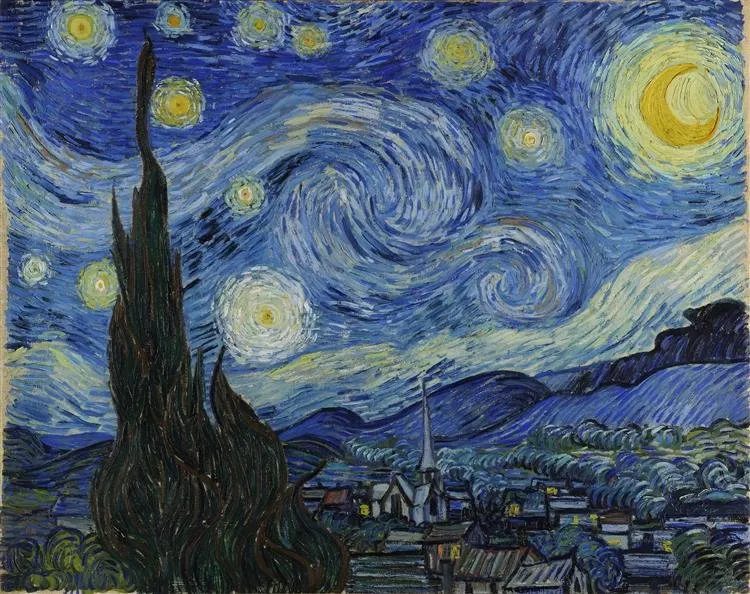Constellations

Van Gogh's night sky is a field of roiling energy. Below the exploding stars, the village is a place of quiet order. Connecting earth and sky is the flamelike cypress, a tree traditionally associated with graveyards and mourning. But death was not ominous for van Gogh. "Looking at the stars always makes me dream," he said, "Why, I ask myself, shouldn't the shining dots of the sky be as accessible as the black dots on the map of France? Just as we take the train to get to Tarascon or Rouen, we take death to reach a star."
The artist wrote of his experience to his brother Theo: "This morning I saw the country from my window a long time before sunrise, with nothing but the morning star, which looked very big." This morning star, or Venus, may be the large white star just left of center in The Starry Night. The hamlet, on the other hand, is invented, and the church spire evokes van Gogh's native land, the Netherlands. The painting, like its daytime companion, The Olive Trees, is rooted in imagination and memory. Leaving behind the Impressionist doctrine of truth to nature in favor of restless feeling and intense color, as in this highly charged picture, van Gogh made his work a touchstone for all subsequent Expressionist painting.
Constellations 🌌, or groups of fixed stars, were given names, such as the Great Bear, Orion, and Taurus. Twelve of these constellations gave their names to the signs of the zodiac, as described before. For astrologers what mattered was not the constellation themselves but the signs of the zodiac named after them. The Ottoman and Latin names of the constellations illustrated by Mirzazâde Salim Efendi are as follows:
Dübb-i Asgar (Ursus Minoris), Dübb-i Ekber (Ursus Majoris), Tinnîn (Draco), Keykâvûs (Cepheus), Avva (Boötes), Fekke (Corona Borealis), Câsî (Hercules), Silyak (Vultur Cadens), Dücâce (Cygnus), Zâtü’l-kürsî (Cassiopeia), Kaytas (Cetus), Cebbâr (Orion), Nehir (Eridanus), Erneb (Lepus), Siyavus (Perseus), Mümsikü’l-a’inne (Ophiuchus,), Hayye (Serpens), Sehm (Sagitta), Ukab (Aquila), Delfîn (Delphinus), Kutta feres (Equuleus), Feresü’l-a’zam (Pegasus), Mer’etü’l-müselsile (Andromeda), Müselles (Triangulum), Kelb-i ekber (Canis Majoris), Kelb-i asgar (Canis Minoris), Sefine (Argo Navis), Batiyye (Crater), Iklîl-i Cenûbi (Corona Australis), Hût-i Cenûbî (Piscis Austrinus), Hamel (Aries), Sevr (Taurus), Cevzâ (Gemini), Seretan (Cancer), Esed (Leo), Sünbüle (Virgo, Virgin), Mîzan (Libra), Akreb (Scorpius), Kavs (Sagittarius), Cedî (Capricornus), Delv (Aquarius), Hût (Pisces), Suca’ (Hydra), el-Gurab (Corvus), Kanturus (Centaurus), Micmere (Ara).
In the brief explanations at the top of each of the miniatures, Salim Efendi gives the name of each constellation and, with the exception of the zodiacal constellations, the number of stars they contain. The positions of the stars are marked on the miniatures. Islamic astronomers did extensive studies of the fixed stars and shapes of the constellations. One of the most important of these was Abdurrahman al-Sûfî (d. 986), who wrote a treatise on the subject entitled Risâlat Suwar al-Kawakib that exerted a considerable influence not only on Islamic but also European astronomy.
Author:
Salim Ayduz